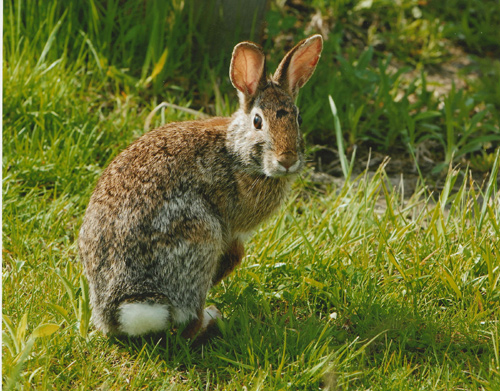Eastern cottontail rabbits are very plentiful in Connecticut and their numbers have been increasing over the years, here and elsewhere. They have grayish brown fur with white mixed in, very long ears, and a white tail that looks like a large cottonball. The large hindfeet are designed for jumping. They weigh 2 to 3 lbs.
Eastern Cottontail Rabbits range through the central and eastern portions of the US. They like brushy areas for cover, overgrown fields and the edges of open woods. They are active year-round and are usually most active at dawn and dusk.
Typical diet in the wild consists of a variety of herbaceous plants during the warm season. They love garden plants and can be quite the garden pest. A fence at least 3 ft high with 2" by 2" mesh should protect a residential garden from these browsers. In the winter cottontails eat buds twigs and bark. Cottontails, like many other rabbits, eat, then retreat to cover. There they will produce soft green droppings that they eat again in order to extract all the nutrients from the plant matter. The firm, dark brown oval pellets one usually associates with rabbit droppings are the final result.
Cottontail rabbits are prolific. They are an important prey species for many carnivores, so making alot of rabbits ensures their survival. They mate from March to September and can produce 3 to 4 litters of 1 to 9 kits in a season. The doe rabbits dig a shallow depression in the ground and line it with grass and fur for a nest where they will bear and raise their young. The mother only comes to the nest at dawn and dusk to nurse, but the rest of the time she is nearby. Do not assume a nest of baby rabbits found alone is abandoned and disturb the kits, mother is probably watching.
These rabbits are often seen in groups. Cottontails create shelters called forms to rest in. They make these by trampling down grasses or small shrubs to make themselves a nice little "cave" in the brush. Abandoned burrows of other animals, such as woodchuck burrows, may be used for winter shelter or escape from a predator. A rabbit perceiving danger may first freeze in place relying on camouflage. If they must run they tend to zig-zag. They know their territory and have memorized routes for escape. If being chased they often circle their territory using these well-known paths. Cottontails can reach speeds of 18 mph and leap 10 to 15 feet.
The Other CottontailThe New England cottontail, Sylvilagus transitionalis, is the rabbit species native to the New England area. They are very hard to tell apart from the eastern cottontail. New England cottontails are slightly smaller and have smaller ears that are black-edged. The population of New England cottontails is diminishing, and they are rarely seen.
Neat Fact
Cottontail rabbits engage in a courtship dance. The male rabbit, the buck, approaches the female face-to-face. The doe will punch at him with her front legs. The buck will then rush forward to have his intended leap over him. The pair will come face-to-face and repeat these actions again until a chase leads to mating.
